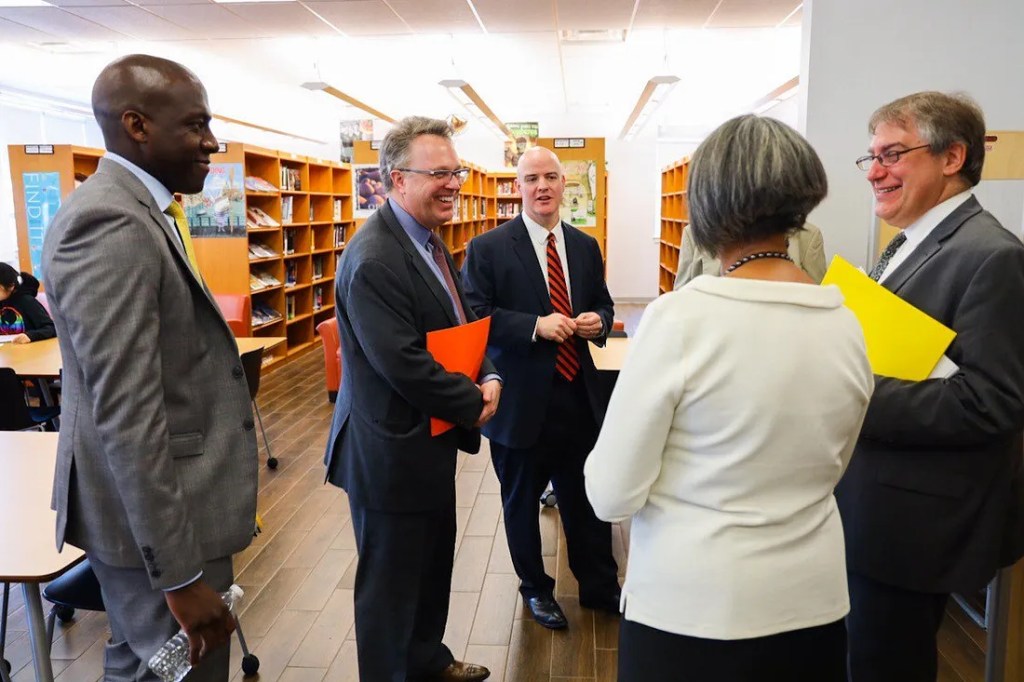
Ahead of New York Fed President Williams’ regional visit to Albany and the Hudson Valley tomorrow, we’re looking back at his last one in May. For that visit — his second of 2019 — he met with community, business, and government leaders throughout Manhattan to hear their views on local economic conditions. Issues around education, affordable housing, gentrification, small businesses, and transportation featured prominently in the day’s discussions.
Supporting Affordable Housing, Bolstering Small Businesses, and Developing Key Skillsets
President Williams and the New York Fed team visited several Manhattan neighborhoods, with considerable variety in terms of demographics, business sectors, and the challenges they face.
Our stops at community organizations in Chinatown and Washington Heights were informative about the evolution and current state of those neighborhoods. While the two neighborhoods are unique in terms of their physical locations and cultures, we saw several consistent themes. As their communities experience rapid change, stakeholders in both locations are grappling with issues such as gentrification and housing affordability, the role of small businesses, and the critical importance of English-language abilities and other skills as recent immigrants acclimate to their new environment. After all, both neighborhoods have significant immigrant populations, and each serves as a gateway community for new arrivals while also providing a home to many longtime residents.
In Washington Heights, we visited the Community League of the Heights (CLOTH), a community development organization that provides a comprehensive framework of services to stabilize and strengthen family life. CLOTH does this in a way that’s sensitive to the unique cultural needs of the community, including by offering Spanish-language-only classes or English as a Second Language workforce development programs. CLOTH Executive Director Yvonne Stennett explained that the organization has long focused on serving the needs of children and families in Hamilton Heights, Washington Heights, and Inwood. To help meet this goal, CLOTH has a community center, which serves as a local hub uniting health, education, and social services, as well as a 6th-12th grade public community school all under one roof.
Stennett explained that housing affordability in the face of rising rents has been a key challenge. Since the late 1970s, CLOTH has led the rehabilitation and development of over 2,000 units of low-income housing, including rental and low-income cooperatives. CLOTH is currently engaged in the rehabilitation of 475 units in addition to the redevelopment of the Inwood Public Library, which will serve as an anchor in the community.
Another challenge that Stennett highlighted was how small businesses in the area have been struggling to remain afloat. In fact, CLOTH estimates that over 300 small businesses in Washington Heights and Inwood have closed in the past two years. With this in mind, CLOTH has worked closely to support businesses throughout these neighborhoods. CLOTH has done this by connecting business owners with legal assistance specifically for lease negotiations, and by offering workshops on how to develop business plans as well as how to upgrade technology and infrastructure.
CLOTH is also actively working to create a business improvement district (BID) along the Broadway commercial corridor from 155th Street to 178th Street, to help preserve the remaining mom-and-pop businesses. BIDs are “geographical areas where local stakeholders oversee and fund the maintenance, improvement, and promotion of their commercial district.” To establish a BID that would provide an organized voice to advocate for all businesses along the corridor, CLOTH has worked with local storeowners, anchor institutions in the community (such as Columbia Presbyterian Hospital and Columbia University Medical Center), and the NYC Department of Small Business Services.
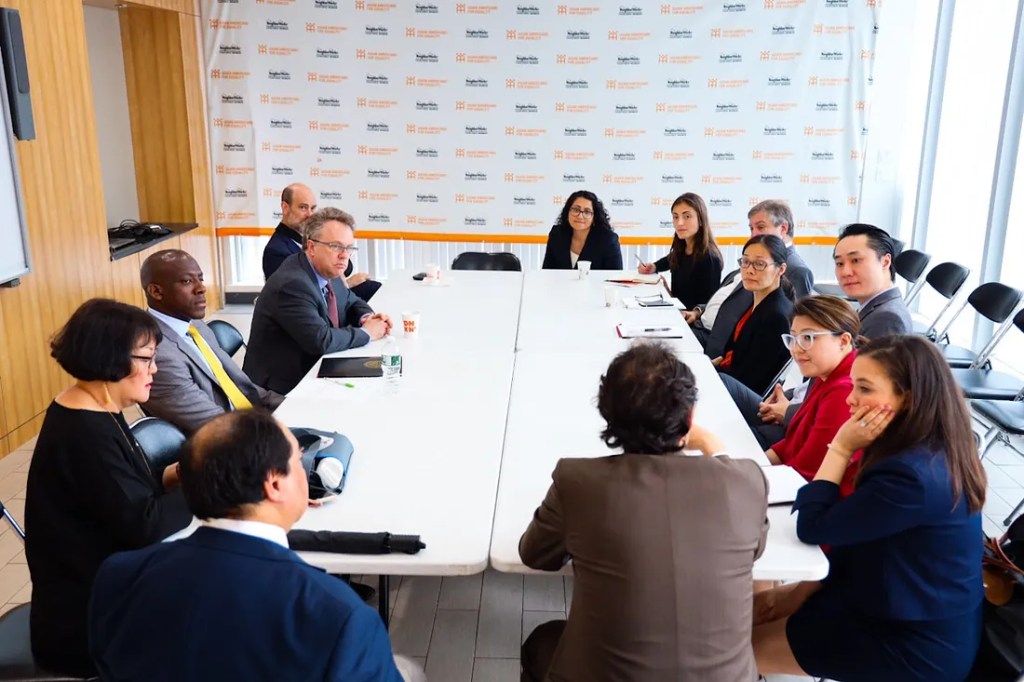
We heard similar concerns in Chinatown during a discussion hosted by the non-profit organization Asian Americans for Equality (AAFE), along with representatives from the Coalition for Asian American Children and Families (CACF), Asian American Federation (AAF), and Chinatown Manpower Project (CMP).
Advocates voiced concerns about long-term residents and local small businesses struggling as costs increase. They honed in on the challenges facing the Asian community, including a significant language barrier for newer and long-term residents. Limited English language literacy and proficiency is an often-cited reason for becoming self-employed or opening a small business. For these entrepreneurs, a lack of English language skills can become a barrier to compliance with city rules and regulations, often leading to fines and tickets.
CACF highlighted the difficulty of providing English language training in addition to workforce training and professional skills development for newer arrivals. This group is vulnerable to wage theft and exploitation in a cash economy so building their skill sets greatly expands their employment opportunities. Meeting participants also noted that many small business owners have a significant portion of their wealth invested in their businesses with few having funds leftover for basics such as website design, business marketing, retirement savings or health insurance plans.
Focusing on Ethics and Collaboration in Higher Education
The day also included a visit to the City College of New York (CCNY), which ranked second among universities nationwide in 2017 for enabling social mobility by lifting low-income students into the middle class.
We met with CCNY Provost Tony Liss and City University Dean of the Sciences Joshua Brumberg to learn more about the Advanced Science Research Center (ASRC). Part of the City University of New York (CUNY) system, the ASRC is located at CCNY and it supports initiatives in nanoscience, photonics, structural biology, neuroscience, and environmental science.
Liss and Brumberg highlighted the collaborative efforts between CCNY and CUNY to develop a research center. They emphasized that a top priority for ASRC is to foster collaboration among the scientific disciplines. As Brumberg noted, “Within a few years the researchers will understand the language and research of their peers in different disciplines which should lead to increased interdisciplinary research.”
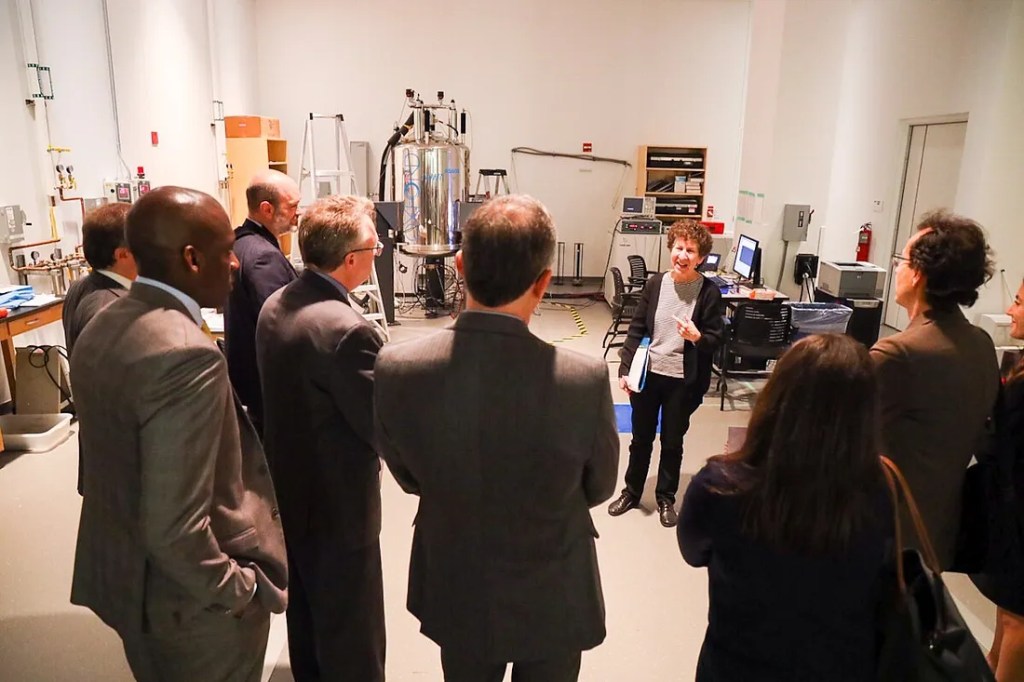
The dialogue also focused on ethics within the scientific community, especially as it pertains to clinical trials and research. Liss and Brumberg explained that maintaining ethical standards in the sciences is of utmost importance, and noted that courses on ethics are often a prerequisite for many key research grants and clinical studies. Since encouraging ethical behavior in the financial services industry is a top priority for the New York Fed, this led to an engaging discussion about how to the address the complex challenge of fostering ethical behavior and integrity, across a range of sectors.
Learning about Public-Private Collaborations and Real Estate Development at Hudson Yards
We also participated in a meeting at Hudson Yards that was organized by the Partnership for New York City, which represents the city’s business leadership. The conversation covered a variety of topics, with a focus on the labor market and job creation in New York City today and in the future. Of note, there was a discussion about the difficulties employers are facing finding qualified workers. Some participants highlighted that, while there are many technology jobs in New York City, most are not entry-level positions and it is difficult to fill positions for those with around three to five years of experience. Others observed that, today, venture capital is more readily available to technology-focused firms in the city than it was a decade ago. On the topic of aging infrastructure, we heard that the air traffic control system in the United States is behind other systems around the world.
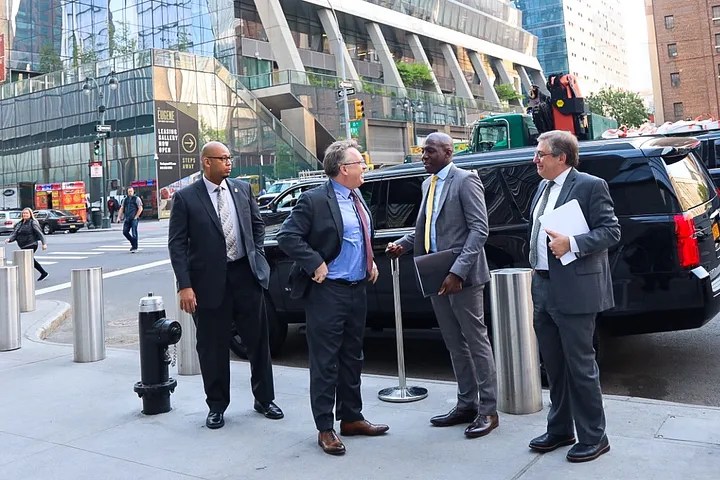
During a tour of the Hudson Yards site that followed, we learned about the Hudson Yards Hiring Network, a public-private effort that focuses on recruiting public housing residents, veterans, formerly incarcerated and homeless individuals, and people with disabilities. Once fully complete, the development is expected to bring over 55,000 jobs to this section of Manhattan’s West Side. We also toured The Shed, New York City’s newest performing arts center, and the Vessel, a walkable public art installation.
According to Related Companies, the developer of Hudson Yards, the site is the largest private real estate development in the United States and the largest development since Rockefeller Center in Manhattan.
Improving Public Transit
We concluded the day by meeting with Metropolitan Transit Authority (MTA) Chairman Patrick Foye and New York City Transit Authority President Andy Byford to learn about their efforts to improve the New York City transit system, a vital underpinning of the region’s economy. Of note, the MTA network maintains the United States’ largest bus fleet and more subway and commuter rail cars than all other U.S. transit systems combined.
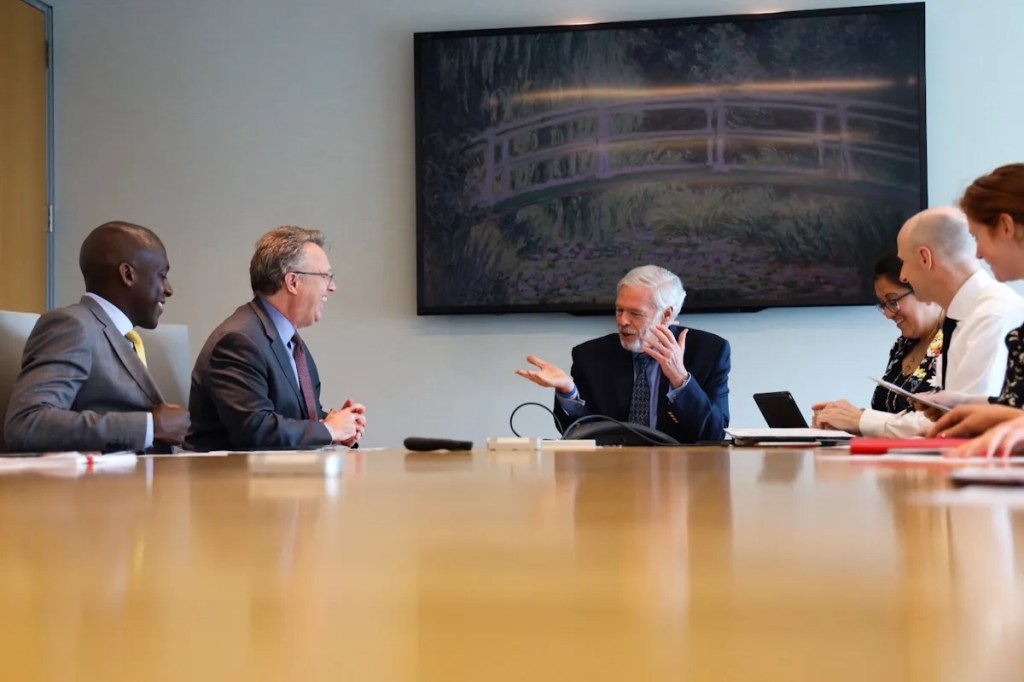
We learned about efforts to bolster customer communications systems, including providing “countdown clocks” to show the timing for incoming trains as well as the use of plain English in public announcements to customers during unexpected delays. Despite this work, many challenges remain, as upgrading infrastructure — some of which dates to around the 1930s — will take time given the scale of the operation.
Separately, Foye and Byford discussed the challenges they face as a public institution competing with private sector wages, in order to retain specialists in areas like information technology and elevator/escalator mechanics. They also observed that having a workforce of over 50,000 employees means that cultural change takes time, but they highlighted efforts underway to promote transparency and encourage their staff to rally behind their common mission of enhancing the quality of life and economic health of the region through reliable and cost efficient transportation services.
Looking Ahead
The next regional visit is tomorrow, to Albany and the Hudson Valley. For more information about the purpose of the New York Fed’s regional visits and what we heard on earlier trips, see our posts on Brooklyn, Buffalo and Niagara Falls, the Bronx, and Puerto Rico and the US Virgin Islands.
This article was originally published by the New York Fed on Medium.
The views expressed in this article are those of the contributing authors and do not necessarily reflect the position of the New York Fed or the Federal Reserve System.










